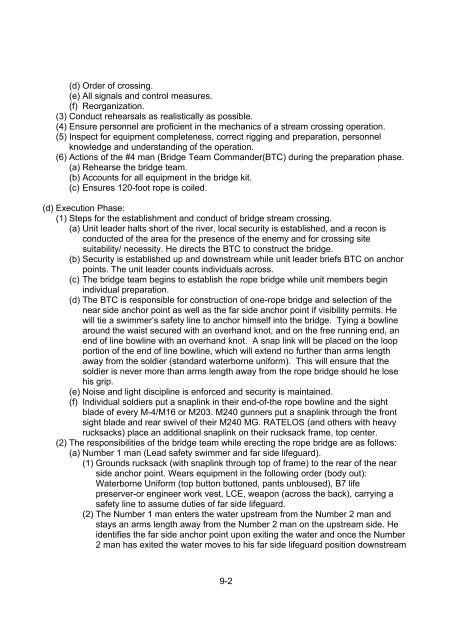You also want an ePaper? Increase the reach of your titles
YUMPU automatically turns print PDFs into web optimized ePapers that Google loves.
(d) Order of crossing.<br />
(e) All signals and control measures.<br />
(f) Reorganization.<br />
(3) Conduct rehearsals as realistically as possible.<br />
(4) Ensure personnel are proficient in the mechanics of a stream crossing operation.<br />
(5) Inspect for equipment completeness, correct rigging and preparation, personnel<br />
knowledge and understanding of the operation.<br />
(6) Actions of the #4 man (Bridge Team Commander(BTC) during the preparation phase.<br />
(a) Rehearse the bridge team.<br />
(b) Accounts for all equipment in the bridge kit.<br />
(c) Ensures 120-foot rope is coiled.<br />
(d) Execution Phase:<br />
(1) Steps for the establishment and conduct of bridge stream crossing.<br />
(a) Unit leader halts short of the river, local security is established, and a recon is<br />
conducted of the area for the presence of the enemy and for crossing site<br />
suitability/ necessity. He directs the BTC to construct the bridge.<br />
(b) Security is established up and downstream while unit leader briefs BTC on anchor<br />
points. The unit leader counts individuals across.<br />
(c) The bridge team begins to establish the rope bridge while unit members begin<br />
individual preparation.<br />
(d) The BTC is responsible for construction of one-rope bridge and selection of the<br />
near side anchor point as well as the far side anchor point if visibility permits. He<br />
will tie a swimmer’s safety line to anchor himself into the bridge. Tying a bowline<br />
around the waist secured with an overhand knot, and on the free running end, an<br />
end of line bowline with an overhand knot. A snap link will be placed on the loop<br />
portion of the end of line bowline, which will extend no further than arms length<br />
away from the soldier (standard waterborne uniform). This will ensure that the<br />
soldier is never more than arms length away from the rope bridge should he lose<br />
his grip.<br />
(e) Noise and light discipline is enforced and security is maintained.<br />
(f) Individual soldiers put a snaplink in their end-of-the rope bowline and the sight<br />
blade of every M-4/M16 or M203. M240 gunners put a snaplink through the front<br />
sight blade and rear swivel of their M240 MG. RATELOS (and others with heavy<br />
rucksacks) place an additional snaplink on their rucksack frame, top center.<br />
(2) The responsibilities of the bridge team while erecting the rope bridge are as follows:<br />
(a) Number 1 man (Lead safety swimmer and far side lifeguard).<br />
(1) Grounds rucksack (with snaplink through top of frame) to the rear of the near<br />
side anchor point. Wears equipment in the following order (body out):<br />
Waterborne Uniform (top button buttoned, pants unbloused), B7 life<br />
preserver-or engineer work vest, LCE, weapon (across the back), carrying a<br />
safety line to assume duties of far side lifeguard.<br />
(2) The Number 1 man enters the water upstream from the Number 2 man and<br />
stays an arms length away from the Number 2 man on the upstream side. He<br />
identifies the far side anchor point upon exiting the water and once the Number<br />
2 man has exited the water moves to his far side lifeguard position downstream<br />
9-2


